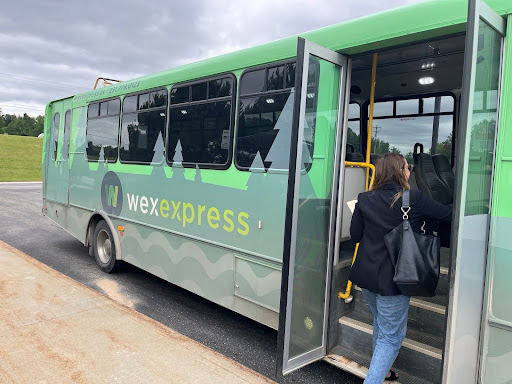Transit Innovation Workshop Series Workshop #1: State DOT Support for the General Transit Feed Specification
10 minutes Author: Shared-Use Mobility Center Date Launched/Enacted: Jan 15, 2025 Date Published: April 1, 2025

Introduction
The American Association of State Highway and Transportation Officials (AASHTO) and the Shared-Use Mobility Center (SUMC) hosted the first virtual workshop of a four-part series on the ways state Departments of Transportation (DOTs) support mobility innovation. The workshops are designed to build on each other to educate on the applications of innovative transit technologies. The January 2025 workshop focused on the General Transit Feed Specification (GTFS) and GTFS-Flex, the extension supporting demand-responsive transportation (DRT) services.
Over 80 practitioners from state DOTs, technical assistance centers, and other organizations joined to discuss how state DOTs are helping small urban and rural communities use data standards like GTFS to make public transportation more visible and usable. Following introductions from AASHTO and SUMC highlighting the importance of collaboration within and across states, the workshop jumped into the GTFS topic, highlighting two examples of state DOTs supporting small urban and rural communities in using data standards to expand transportation access and overcome coordination barriers:
- Thomas Craig, from Washington DOT (WSDOT), discussed the state’s efforts to build and maintain GTFS data statewide.
- Janet Geissler, from Michigan DOT (MDOT), shared an update on its United States Department of Transportation (USDOT) Strengthening Mobility and Revolutionizing Transportation (SMART) Grant project to implement GTFS-Flex in rural communities.
The workshop concluded with a Questions & Answers discussion.
Transit data specification definitions covered in the workshop
- The General Transit Feed Specification (GTFS), or GTFS-Static, is the global open data standard that publishes fixed-route transit service information to the public. GTFS is published through rider-facing software like Google Maps, Apple Maps, TransitScreen, and the Transit App. GTFS is now captured in annual National Transit Database reporting.
- GTFS-Flex increases the discoverability of DRT services like dial-a-ride, deviated routes, or point-to-zone services, which are based on customer demand rather than fixed-route transit schedules. In rural communities serving vast distances, GTFS-Flex helps riders find available transit services through trip-planning applications.
- GTFS Realtime displays real-time information about transit service, like vehicle locations, adjusting scheduled arrival times to actual, and providing alerts on service disruptions. Service disruption examples could include inclement weather, accidents, construction, and station or route closures.
- The General On-Demand Format Specification (GOFS) project goal is to develop an open standard for booking DRT services. MobilityData is organizing this effort and drawing from other DRT booking standards to outline a GOFS framework. GOFS-Lite was developed as an interim product by Transit app to define a lightweight format for purely on-demand transport services to provide information about their offerings, like ridehail services (e.g; taxis or TNCs), on-demand microtransit (like Metro Micro or DRT On Demand), and paratransit.
Major Takeaways
This workshop emphasized several key takeaways for state DOTs on the importance of GTFS and its extensions, as well as practical steps for adopting and implementing them to improve transportation access and address coordination challenges.
Why is GTFS Important?
- GTFS makes it easier for riders to discover and plan their public transit trips. Without GTFS, a rider must reach out to each agency hoping to find their schedule to plan a trip.
- GTFS data can be used for planning, researching transit service levels, identifying gaps in service coverage, supporting the rider travel experience, and exploring opportunities to support emergency management planning and the delivery of services.
- As an open data standard, GTFS supports interoperability across platforms and eliminates vendor lock on a specific trip-planning platform.
- GTFS is now a requirement for the National Transit Database (NTD).
- For rural and small urban communities, GTFS-Flex is particularly important, as it extends the utility of GTFS to DRT services, often the primary form of public transportation in these areas. When fully deployed in all trip planners, GTFS-Flex will ease the discoverability of DRT services in rural areas without fixed-route services.
How to Get Started?
- State DOTs can distribute grants to assist smaller transit agencies and community transportation organizations to develop and implement GTFS and other supporting data standards.
- Implementing GTFS and GTFS-Flex can produce a high return on investment. An investment of around $100k annually, for a state the size of Washington, supports the statewide development of the data feeds.
- State DOTs can lead through collaboration to partner with transportation providers and local transit agencies to implement GTFS trip information data feeds. State DOTs are well-positioned to assist smaller agencies across a state with limited technical or staff capacity.
Presentation Overviews
Thomas Craig, Washington State Department of Transportation

Thomas Craig, Transportation Planner at Washington State Department of Transportation
Thomas Craig, Transportation Planner at WSDOT presented: GTFS needs to be easy. Craig focused on viewing GTFS as a shared responsibility that requires DOT investment to realize the benefits. GTFS plays a role in meeting the needs of both transit agencies and state DOTs. Transit agencies use GTFS for planning and research, as it provides critical data on stops, schedules, and fares. It also integrates with customer-facing information systems to provide transportation users with the information needed to utilize service effectively. For state DOTs, it can be used to streamline service inventories for grant management, enhance understanding of services on the ground, collect data required for NTD reporting, and provide an overview of the statewide transportation network. Compared to the large-scale investments state DOTs often make, investing in GTFS development requires a much smaller investment; often, less than $100,000 in funding is needed to launch a more accessible and cost-effective initiative state-wide.
WSDOT’s initiative began in 2021, with building and maintaining GTFS data for any agency in the state without existing data. Since then, the initiative has expanded to incorporate data into the Statewide Frequent Transit Service Study, develop updated GIS layers for all agencies in the state (previously, only ⅔ of agencies in the state had updated GIS layers), and publish GTFS feeds to a central hub. In 2025, WSDOT plans to incorporate flex data into an accessibility analysis study, launch a shared data archiving and distribution system in collaboration with the Oregon Department of Transportation (ODOT), and incorporate the findings in an updated Statewide Public Transportation Plan.
WSDOT funded its GTFS efforts by utilizing Rural Transportation Assistance Program (RTAP) grants. The agency designated a dedicated individual to oversee how various technology programs compare and explore ways to utilize data sets across agency needs. Also central to the DOT’s efforts were collaboration and relationship-building to strengthen ties with transit agencies, advocates, and community organizations. These connections allowed WSDOT to engage with more transportation providers on the benefits and values of GTFS while addressing potential data users’ concerns about data security risks.
Janet Geissler, Michigan Department of Transportation

Janet Geissler, Mobility Innovations Specialist at Michigan Department of Transportation
Janet Geissler, Mobility Innovations Specialist at MDOT, presented Advancing Rural Mobility in Michigan. Geissler focused on the state’s efforts to assist rural agencies in implementing GTFS-Flex, encouraging agencies to use open data and eventually contributing to the expanded functionality of the state’s Mobility as a Service (MaaS) system, currently in development. MDOT’s Statewide MaaS system aims to provide a single interface to access transit information across the state.
While most urban transit agencies in Michigan have adopted the use of open standard GTFS to support their operations and communications with users, many, if not all, rural agencies in the state were not supported by GTFS data due to their services being primarily DRT or deviated fixed-route. However, the adoption of GTFS-Flex presented an opportunity to advance rural agencies’ open data integration and provide demand-response riders with the information they needed to better utilize transit services.
In 2022, MDOT was awarded a grant under the USDOT Strengthening Mobility and Revolutionizing Transportation (SMART) program, to support the development of GTFS-Flex for four rural agencies, selected for their level of technology readiness. The SMART program uses a two-stage process; Stage 1 grants are focused on planning and prototyping to develop data feeds and infrastructure that address mobility needs, and Stage 2 grants fund implementation for selected Stage 1 awardees. MDOT plans to apply for a Stage 2 SMART grant to create and implement data feeds for rural agencies statewide, explore other open data standards, and further connections with urban agencies.

MDOT staff and consulting partner HNTB explain the project to staff at the Cadillac/Wexford Transit Authority. Credit: MDOT
MDOT’s schedule was delayed due to the contracting process, prompting a shift from its original plan to conduct a procurement process for hiring a vendor to develop data feeds and a trip planner app. Instead, MDOT leveraged its partnership with private consultant HNTB, a key collaborator in its SMART grant application. The expanded partnership allowed MDOT to forgo a lengthy procurement process, enabling the agency to get back on schedule, even moving ahead of schedule and reducing project costs. With the time and money saved, MDOT secured approval to expand the pilot program to include 12 additional agencies, strategically selected based on their geographic location to demonstrate how data feeds can be used across jurisdictions.
MDOT’s federal funding from the SMART grant expired in February 2025, but MDOT is taking steps to sustain the project by using state funds until a Stage 2 SMART grant is awarded.
Looking ahead, MDOT hopes to develop data feeds for all rural agencies across the state, explore additional data standards such as the General On Demand Specification (GOFS), and provide training for agencies on system administration so they can independently maintain their feeds. MDOT plans to tie this work into its future MaaS platform and to continue advocating for wider adoption of GTFS-Flex.

A screenshot of MDOT’s trip planning tool. Credit: MDOT
Conclusion
GTFS and GTFS-Flex play a key role in supporting transit and improving service coordination among providers, enabling services to be visible on trip planning apps and supporting transit planning and operations. State DOTs can begin implementation with modest investments, leveraging procurement processes and building partnerships to overcome coordination challenges and develop mobility solutions.
By sharing successes and working together, practitioners can develop programs and strategies that benefit the widest possible audience, improving mobility and access to services, goods, and employment opportunities.
Resources
- National Rural Transit Assistance Program offers a GTFS Builder tool and provides GTFS technical support
- General Transit Feed Specification (GTFS-Static)
- GTFS Realtime – General Transit Feed Specification
- GTFS-Flex extension information
- General On-demand Feed Specification project and General On-Demand Format Specification lite (GOFS-lite)